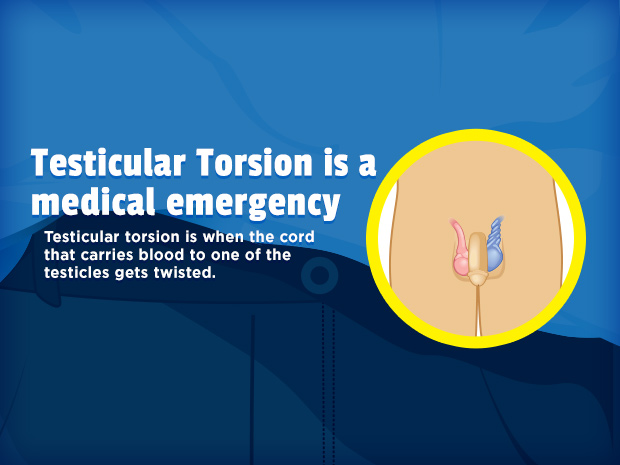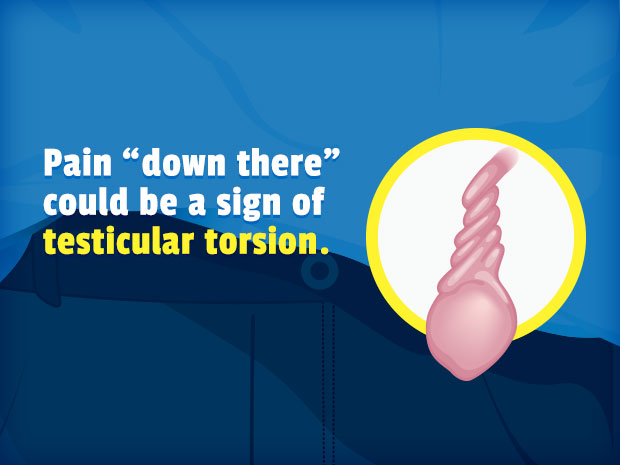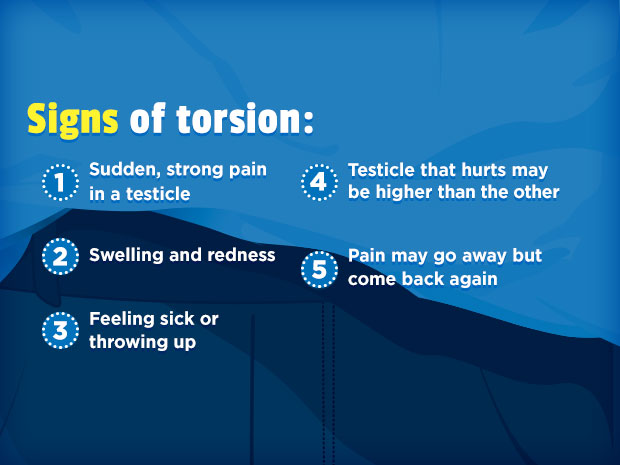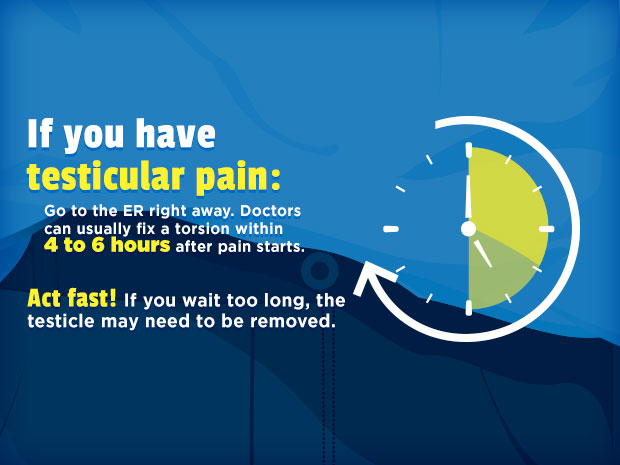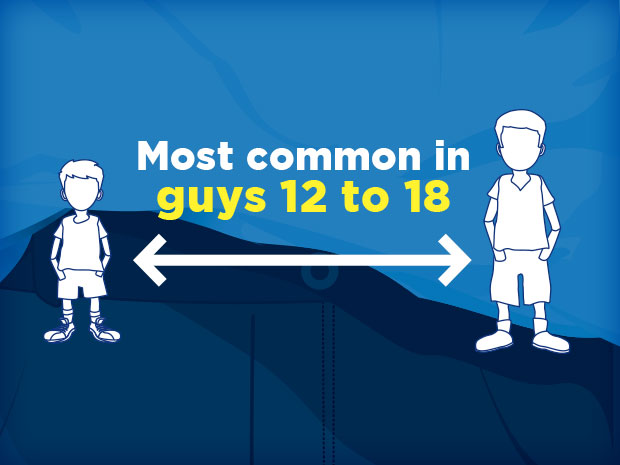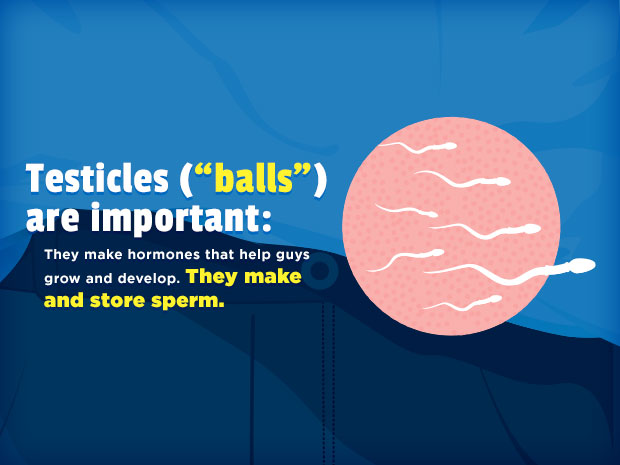Testicular Torsion
What Is Testicular Torsion?
Testicular torsion is a medical emergency. It happens when the spermatic cord, which provides blood flow to the testicle, rotates and becomes twisted. This cuts off the testicle's blood supply and causes sudden pain and swelling.Testicular torsion usually requires immediate surgery to save the testicle.
For most boys, talking seriously about their private parts can be a little embarrassing. But it's important that they know to tell a parent or a health care provider if they ever have genital pain, especially in the scrotum or testes.
How Does Testicular Torsion Happen?
The scrotum is the sack of skin beneath the penis. Inside the scrotum are two testes (plural of testis), also called testicles. Each testicle is connected to the rest of the body by a blood vessel called the spermatic cord. Testicular torsion happens when a spermatic cord becomes twisted, cutting off the flow of blood to the attached testicle.
Testicular torsion (also called testis torsion) requires immediate surgery to fix. If it goes on too long, it can result in severe damage to the testicle and even its removal.
Who Gets It?
Most cases of testicular torsion are in males who have a genetic condition called the bell clapper deformity. Normally, the testicles are attached to the scrotum, but in this condition the testicles aren't attached, and are more likely to turn and twist within the scrotum.
Torsion can happen to boys and men of any age, but is most common in 12- to 18-year-olds. It can happen after strenuous exercise, while someone is sleeping, or after an injury to the scrotum. Often, though, the exact cause isn't known.
What Are the Signs & Symptoms of Testicular Torsion?
If your son has testicular torsion, he'll feel a sudden, possibly severe pain in his scrotum and one of his testicles. The pain can get worse or ease a bit, but probably won't go away completely.
If your son has sudden groin pain, get him to a hospital emergency room as soon as you can. Because he might need surgery, it's important to not give your son anything to eat or drink before you get medical care.
Other symptoms:
- swelling, especially on one side of the scrotum
- nausea and vomiting
- belly pain
- one testicle appears to be higher than the other
Sometimes, the spermatic cord can become twisted and then untwist itself without treatment. This is called torsion and detorsion, and it can make testicular torsion more likely to happen again in the future.
If your son's spermatic cord untwists and the pain goes away, it might be easy to dismiss what happened, but you should still call a doctor. Surgery can be done to secure the testicles and make testicular torsion unlikely to happen again.
How Is Testicular Torsion Diagnosed?
When you get to the hospital, a doctor will examine your son's scrotum, testicles, abdomen, and groin and might test his reflexes by rubbing or pinching the inside of his thigh. This normally causes the testicle to contract, which probably won't happen if he has a testicular torsion.
The doctor also might do tests to see if the spermatic cord is twisted, including:
- Ultrasound: High-frequency waves are used to make an image of the testicle and check blood flow.
- Urine tests or blood tests: These can help the doctor see if symptoms are due to an infection instead of a torsion.
Sometimes, a doctor will have to do surgery to make a diagnosis of testicular torsion. Other times, when the physical exam clearly points to a torsion, the doctor will do emergency surgery without other testing in order to save the testicle.
Saving a testicle becomes more difficult the longer the spermatic cord stays twisted. The degree of twisting (whether it's one entire revolution or several) determines how quickly the testicle will become damaged. As a general rule:
- within about 4–6 hours of the start of the torsion, the testicle can be saved 90% of the time
- after 12 hours, this drops to 50%
- after 24 hours, the testicle can be saved only 10% of the time
How Is Testicular Torsion Treated?
Testicular torsion almost always needs surgery to fix. In rare cases, the doctor might be able to untwist the spermatic cord by pushing on the scrotum, but most males will still need surgery to attach both testicles to the scrotum to prevent torsion from happening in the future.
Most torsion surgeries are done on an outpatient basis (with no overnight hospital stay). If your son has a torsion, he'll get a painkiller and general anesthesia to sleep and not feel pain during the procedure.
The surgeon will make a small cut in the scrotum, untwist the spermatic cord, and stitch both testicles to the inside of the scrotum to prevent future torsions. Afterward, your son will go to a recovery room to rest for an hour or two.
After surgery, your son will need to avoid strenuous activities for a few weeks, and if he's sexually active, he'll need to avoid all sexual activity. Talk to the doctor about when it will be safe for your son to return to his normal activities.
Testicle Removal
If a torsion goes on too long, doctors can't save the affected testicle and will remove it in a procedure called an orchiectomy (or-kee-EK-teh-mee). Most boys who have a testicle removed but still have a viable testicle can father children later in life. Many also opt for a prosthetic, or artificial, testicle a few months after surgery. This can help make some boys feel more comfortable about their appearance.
With newborn boys, saving the testicle depends on when the torsion happens. If torsion happens before a baby is born, it may be impossible to save the testicle. In this case, the doctor may recommend a surgery at a later date to remove the affected testicle. If torsion symptoms appear after a baby is born, the doctor may recommend emergency surgery to correct the testicle.
What Else Should I Know?
Boys need to know that genital pain is serious. Ignoring pain or simply hoping it goes away can lead to severe damage to the testicle and even its removal.
Even if pain in the scrotum that goes away, your son still needs to tell you or a doctor and get checked out. A torsion that goes away makes him more likely to have another one. Doctors can greatly reduce the risk of another torsion by securing the testicles to the scrotum.
Even if your son had a torsion that led to the loss of a testicle, he can still lead a normal life, just like anyone else. The loss of one testicle won't prevent a man from having normal sexual relations and is unlikely to interfere with fathering children.



